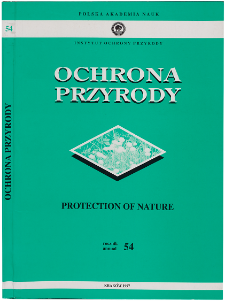
Object
Title: Zmiany liczebności i miejsca gniazdowania dzięcioła dużego Dendrocopos major i średniego D. medius w rezerwacie "Las Bielański" w Warszawie ; Changes in the numbers and nest sites of the Great Spotted Woodpecker Dendrocopos major and Middle Spotted Woodpecker D. medius in the Las Bielański Reserve in Warsaw
Contributor:
Institute of Nature Conservation of the Polish Academy of Sciences
Publisher:
Instytut Ochrony Przyrody Polskiej Akademii Nauk
Place of publishing:
Description:
29 cm ; ilustracje ; bibliografia na stronach 159-160 ; ISSN 0078-3250
Type of object:
References:
Aulen G. 1988. Ecology and distribution history of the White-Backed Woodpecker Dendrocopos leucotos in Sweden. SLU Report 14, Uppsala.
Baum T., Trojan P. (red.) 1982. Las Bielański w Warszawie. Rezerwat Przyrody. PWN, Warszawa.
Busse P., Gotzman J. 1962. Konkurencja gniazdowa i lęgi mieszane u niektórych gatunków dziuplaków. Acta Orn. 7: 1-32.
Cramp S. (red.) 1985.The bird of western Palearctic. 4, Oxford University Press, Oxford.
Hagvar S., Hagvar G., Monness E. 1990. Nest site selection in Norwegian woodpeckers. Holarct. Ecol. 13: 156-165.
Hansson L. 1992. Requirements by the Great Spotted Woodpecker Dendrocopos major for a suburban life. Ornis Svecica 2: 1-6.
Jabłoński B., Luniak M. 1964. Dzięcioł białogrzbiety, Dendrocopus Ieucotos (Bechst.) w Lasku Bielańskim. Not. orn. 5, 2—4: 29.
Karolewski M. A. 1981. Specyfika i status ekologiczny miasta. Wiadomości Ekologiczne 27: 3-35.
Luniak M. 1982. Ptaki rezerwatu Las Bielański w Warszawie. Ochr. Przyr. 44: 219-242.
Luniak M. 1991. Awifauna Lasu Bielańskiego w Warszawie 15 lat po ustanowieniu rezerwatu. Parki Nar. Rez. Przyr. 10: 167-181.
Mazgajski T. (1994). Dziuple wykute przez dzięcioły jako miejsca gnieżdżenia się dziuplaków wtórnych.Praca magisterska. Zakład Ekologii UW. Msc.
Miścicki S. (red.) 1992. Plan ochrony częściowego rezerwatu krajobrazowego Las Bielański. Warszawa, Katedra Urządzania Lasu i Geodezji Leśnej SGGW. Msc.
Nilsson S. G., Olsson O., Svensson S., Wiktander U. 1992. Population trends and fluctuations in Swedish woodpeckers. Ornis Svecica 2: 13-21.
Pettersson B. 1984. Ecology of an isolated population of the middle spotted woodpecker Dendrocopos medius (L.), in the extinction phase. SLU Report 11 Uppsala.
Ryant T. P. 1989. Statistical methods for quality improvement. Wiley & Sons, New York.
Saari L., Mikusiński G. 1996. Population fluctuations of woodpecker species on the Baltic island of Aasla, SW Finland. Ornis Fennica 73: 168-178.
Tomiałojć L. 1990. Ptaki Polski. Rozmieszczenie i liczebność. PWN, Warszawa.
Tomiałojć L., Wesołowski T. 1996. Structure of the primaeval forest bird community during 1970s and 1990s (Białowieża National Park, Poland). Acta Orn. 25: 321-351.
Virkkala R., Rajasarkka A., Vaisanen R. A., Vickholm M., Virolainen E. 1994. Conservation value of nature reserve: do hole-nesting birds prefer protected forests in southern Finland? Ann. Zool. Fenn. 31: 173-186.
Wesołowski T. 1989. Nest-sites of hole-nesters in a primaeval temperate forest (Białowieża National Park, Poland). Acta Orn. 25: 321-351.
Wesołowski T. 1994. Variation in the numbers of resident birds in a primaeval temperate forest: are winter weather, seed crop, caterpillars and interspecific competition involved? W: Bird numbers 1992. Red. E.J. M. Hagemeijer, T. J. Verstrael. Statistics Netherlands, Heerlen, s. 203-211.
Wesołowski T., Tomiałojć L. 1986. The breeding ecology of woodpeckers in a temperate primaeval forest - preliminary data. Acta Om. 22: 1-19.
Relation:
Volume:
Start page:
End page:
Detailed Resource Type:
Resource Identifier:
Source:
Bibl. IOP PAN, sygn. F 1, III 69/cz, III 70/cz
Language:
Language of abstract:
Rights:
Creative Commons Attribution BY 3.0 PL license
Terms of use:
Copyright-protected material. [CC BY 3.0 PL] May be used within the scope specified in Creative Commons Attribution BY 3.0 PL license, full text available at: ; -
Digitizing institution:
Institute of Nature Conservation of the Polish Academy of Science
Original in:
Institute of Nature Conservation of the Polish Academy of Science
Projects co-financed by:
Access:
Object collections:
Last modified:
May 26, 2021
In our library since:
Apr 22, 2020
Number of object content downloads / hits:
477
All available object's versions:
https://rcin.org.pl/iop/publication/113527

 INSTYTUT ARCHEOLOGII I ETNOLOGII POLSKIEJ AKADEMII NAUK
INSTYTUT ARCHEOLOGII I ETNOLOGII POLSKIEJ AKADEMII NAUK
 INSTYTUT BADAŃ LITERACKICH POLSKIEJ AKADEMII NAUK
INSTYTUT BADAŃ LITERACKICH POLSKIEJ AKADEMII NAUK
 INSTYTUT BADAWCZY LEŚNICTWA
INSTYTUT BADAWCZY LEŚNICTWA
 INSTYTUT BIOLOGII DOŚWIADCZALNEJ IM. MARCELEGO NENCKIEGO POLSKIEJ AKADEMII NAUK
INSTYTUT BIOLOGII DOŚWIADCZALNEJ IM. MARCELEGO NENCKIEGO POLSKIEJ AKADEMII NAUK
 INSTYTUT BIOLOGII SSAKÓW POLSKIEJ AKADEMII NAUK
INSTYTUT BIOLOGII SSAKÓW POLSKIEJ AKADEMII NAUK
 INSTYTUT CHEMII FIZYCZNEJ PAN
INSTYTUT CHEMII FIZYCZNEJ PAN
 INSTYTUT CHEMII ORGANICZNEJ PAN
INSTYTUT CHEMII ORGANICZNEJ PAN
 INSTYTUT FILOZOFII I SOCJOLOGII PAN
INSTYTUT FILOZOFII I SOCJOLOGII PAN
 INSTYTUT GEOGRAFII I PRZESTRZENNEGO ZAGOSPODAROWANIA PAN
INSTYTUT GEOGRAFII I PRZESTRZENNEGO ZAGOSPODAROWANIA PAN
 INSTYTUT HISTORII im. TADEUSZA MANTEUFFLA POLSKIEJ AKADEMII NAUK
INSTYTUT HISTORII im. TADEUSZA MANTEUFFLA POLSKIEJ AKADEMII NAUK
 INSTYTUT JĘZYKA POLSKIEGO POLSKIEJ AKADEMII NAUK
INSTYTUT JĘZYKA POLSKIEGO POLSKIEJ AKADEMII NAUK
 INSTYTUT MATEMATYCZNY PAN
INSTYTUT MATEMATYCZNY PAN
 INSTYTUT MEDYCYNY DOŚWIADCZALNEJ I KLINICZNEJ IM.MIROSŁAWA MOSSAKOWSKIEGO POLSKIEJ AKADEMII NAUK
INSTYTUT MEDYCYNY DOŚWIADCZALNEJ I KLINICZNEJ IM.MIROSŁAWA MOSSAKOWSKIEGO POLSKIEJ AKADEMII NAUK
 INSTYTUT PODSTAWOWYCH PROBLEMÓW TECHNIKI PAN
INSTYTUT PODSTAWOWYCH PROBLEMÓW TECHNIKI PAN
 INSTYTUT SLAWISTYKI PAN
INSTYTUT SLAWISTYKI PAN
 SIEĆ BADAWCZA ŁUKASIEWICZ - INSTYTUT TECHNOLOGII MATERIAŁÓW ELEKTRONICZNYCH
SIEĆ BADAWCZA ŁUKASIEWICZ - INSTYTUT TECHNOLOGII MATERIAŁÓW ELEKTRONICZNYCH
 MUZEUM I INSTYTUT ZOOLOGII POLSKIEJ AKADEMII NAUK
MUZEUM I INSTYTUT ZOOLOGII POLSKIEJ AKADEMII NAUK
 INSTYTUT BADAŃ SYSTEMOWYCH PAN
INSTYTUT BADAŃ SYSTEMOWYCH PAN
 INSTYTUT BOTANIKI IM. WŁADYSŁAWA SZAFERA POLSKIEJ AKADEMII NAUK
INSTYTUT BOTANIKI IM. WŁADYSŁAWA SZAFERA POLSKIEJ AKADEMII NAUK
































